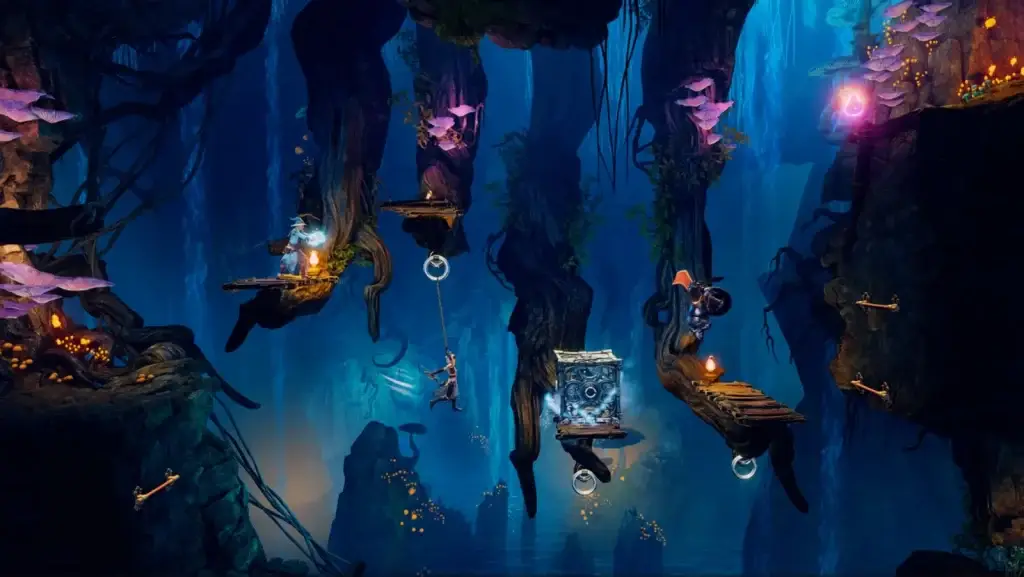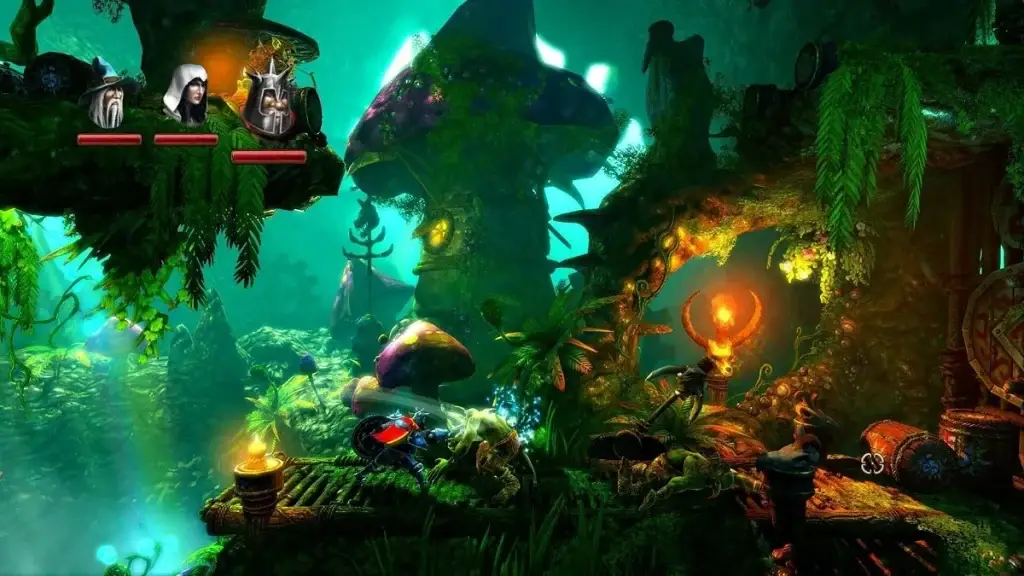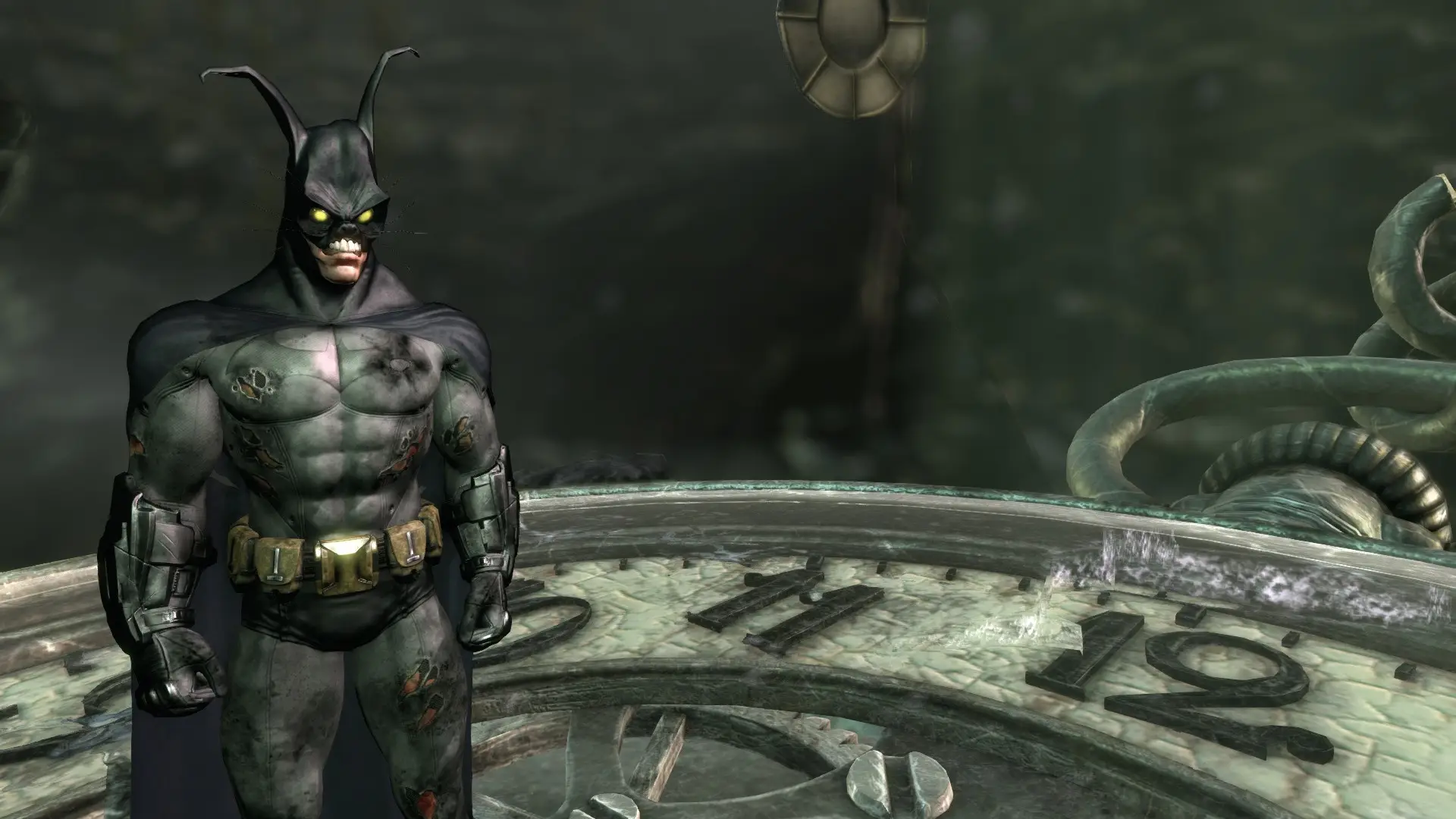Three heroes, magic and insurmountable obstacles – this is what awaits everyone who discovers the game Trine. In a world filled with light and shadows, a magical arch is lit by three characters: Amadeus – a wise magician, Zoya – a cunning thief, and Pontius – a brave knight. The team goes on a magical adventure: each level reveals the unique abilities of the characters and conveys the atmosphere of the magical universe. The project continues to win the hearts of gamers thanks to graphics and a harmonious combination of puzzles, storyline and music.
The magical atmosphere and plot of the game Trine: why you should play
The developers skillfully made gamers experience a sense of magic, transferring them to a world where each location seems alive. Forest paths illuminated by flickering lights, stone palaces with mosaic stained glass windows and shaky bridges over abysses – all these are not just elements of the environment, but real works of art. The atmosphere is enchanting from the first level: the play of light and shadows here works like magic, turning every movement into a visual delight. The music in Trine harmoniously complements the magical atmosphere of the game, creates a sense of presence, and the magnificent melodies enhance every moment of the game.

Locations:
- Enchanted Forest: A location full of mysteries and forest creatures. Fireflies, green fog and flickering lights all around create the atmosphere of a fairy-tale forest. The trees act not only as decorations, but are also part of the puzzles.
- Dungeons of the Royal Castle: Narrow corridors, darkened walls and intricate traps. Here, players encounter numerous enemies and look for hidden levers to open doors.
- Bridge of Shadows: Dangerous shaky bridges stretched across deep chasms. The play of light and shadow makes this location especially tense. At every step, the player is faced with collapsing platforms.
- Crystal Cave: Dazzlingly sparkling crystals, the light of which reflects off the walls and helps to illuminate the path. Here, precise calculations and courage are required to overcome the puzzles.
- Dilapidated Ruins: Ancient ruins filled with mysterious mechanisms and traces of long-vanished civilizations. The puzzles here are associated with the activation of various ancient artifacts.
- Burning Wasteland: A location with fiery lava flows and volcanic activity. Enemies become stronger, and temperature hazards require players to be extremely careful.
- Air Castles: Floating islands and castles that are held together by magical power. Players will have to move between platforms using magical winds and hooks.
- Sunken Temple: A half-flooded location where water plays an important role. Puzzles here are associated with changing water levels and finding paths in underwater labyrinths.
- Dark Labyrinth: A labyrinth full of enemies and intricate paths. The lack of light makes this location difficult to navigate, and hidden traps force you to be on your guard.
- Dragon Cliff: High cliffs where players will have to fight mythical creatures and look for a way up. The danger lies in strong winds and fragile bridges.
Trine Game Story: Journey in the Name of Harmony
 The story begins with a magical relic – the Trine artifact itself, which unites three heroes. The magician Amadeus moves objects with his spells, opens hidden paths. The thief Zoya masterfully uses a bow and hook to bypass traps and find hidden treasures. The knight Pontius fearlessly engages in battle with monsters, protecting his comrades and paving the way forward. This trio is forced to work together to pass the tests and restore balance to their world. The main feature is the continuous interaction of the heroes, which not only facilitates the passage of levels, but also creates an unforgettable adventure.
The story begins with a magical relic – the Trine artifact itself, which unites three heroes. The magician Amadeus moves objects with his spells, opens hidden paths. The thief Zoya masterfully uses a bow and hook to bypass traps and find hidden treasures. The knight Pontius fearlessly engages in battle with monsters, protecting his comrades and paving the way forward. This trio is forced to work together to pass the tests and restore balance to their world. The main feature is the continuous interaction of the heroes, which not only facilitates the passage of levels, but also creates an unforgettable adventure.
Why Trine is so popular among gamers
The uniqueness of the project lies not only in the visual style and storyline, but also in the gameplay mechanics. One of the key factors of popularity is the presence of a multiplayer mode. The possibility of cooperative passage, where each user takes on the role of one of the characters, adds depth to the interaction and makes each game session unique. The concept combines a platformer with physical puzzles: the solution to the problem depends on the creative approach of each of the characters. The flexibility of the mechanics allows everyone to solve problems in their own way, which causes the effect of personal involvement.
Is Trine worth playing? Pros and cons
Definitely yes, and here’s why. Among the advantages of the game are:
- Amazing graphics and attention to detail at each level.
- The ability to control three unique characters, each with their own abilities.
- Multiplayer mode, making the session even more exciting.
But there are some downsides:
- Sometimes the character controls seem a bit imprecise, making it difficult to solve puzzles.
- Some levels may seem too difficult for beginners, requiring quick reactions and a strategic approach.
Trine series: evolution and achievements
Since the release of the first part of Trine in 2009, the game has undergone many changes: each new version brought something unique and fresh. The second part added new locations, water effects and the possibility of a multiplayer session over the network, which attracted even more fans. Trine 3 offered a transition to 3D, which gave a new look at the already beloved mechanics.

The series not only evolved visually, but also improved the gameplay, adding more interesting puzzles and elements of interaction between the characters. The latest part, The Nightmare Prince, returned to the traditional 2.5D format, improving it visually, and made each level a real adventure.
Conclusion
 In the end, Trine is not just a platformer, but a real journey into the world of magic and mystery. The combination of a fascinating plot, unique graphics and enchanting music creates a unique atmosphere that remains in the memory of everyone who has ever played. Test your strength in this magical adventure and find out why millions of players around the world choose this project again and again.
In the end, Trine is not just a platformer, but a real journey into the world of magic and mystery. The combination of a fascinating plot, unique graphics and enchanting music creates a unique atmosphere that remains in the memory of everyone who has ever played. Test your strength in this magical adventure and find out why millions of players around the world choose this project again and again.
 en
en  de
de  ar
ar  es
es  nl
nl  hi
hi  fr
fr  it
it  pt
pt  el
el 










